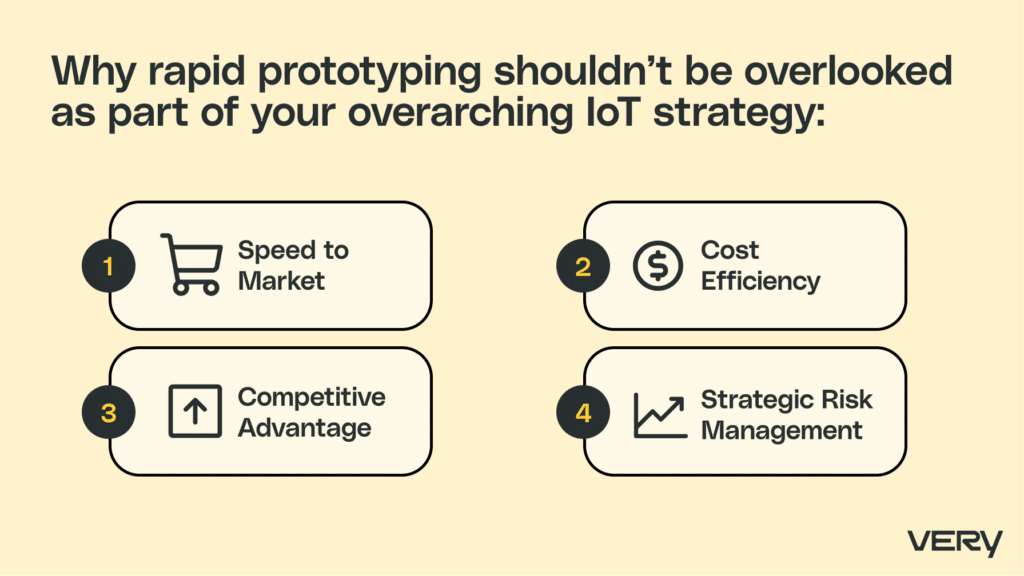BLOG
Accelerate Speed-to-Market and Gain a Competitive Edge with IoT Rapid Prototyping
Skill isn’t the only thing that makes competitive IoT leaders — speed and strategy play crucial roles, too. If you’re considering entering the market or expanding your existing IoT footprint, it might be time to reassess your speed-to-market strategy.
Being the first to launch a viable product or service offers a significant competitive advantage to IoT companies entering new markets. Entering the market earlier rather than later decreases your chances of facing cutthroat competition at the onset, which is why implementing a speed-to-market strategy shouldn’t be overlooked. An important component of forming this strategy is IoT rapid prototyping.
Let’s take a look at its advantages and how it can help align with strategic business objectives.
Rapid Prototyping: The Key To Staying Competitive in IoT
The name might imply otherwise, but rapid prototyping in IoT isn’t just about speed. In addition to building and deploying prototypes quickly, rapid prototyping refers to informed decision-making, risk management, and aligning product development with market needs and opportunities. Here’s why it shouldn’t be overlooked as part of your overarching IoT strategy:
- Speed to Market: The window of opportunity for new products can close quickly in the IoT landscape. Rapid prototyping accelerates the development process, allowing businesses to test ideas and iterate on designs at a pace that matches the market’s dynamism. This agility ensures that the product not only reaches the market faster but does so in a form that’s more likely to succeed.
- Competitive Advantage: Rapid prototyping provides the opportunity to explore more innovative ideas and refine them based on real-world feedback. This process not only enhances the product’s market fit but also positions companies as a leader in innovation, staying ahead of competitors who stick to traditional, slower development cycles.
- Cost Efficiency: Conventional wisdom suggests that faster development increases costs. Rapid prototyping disproves this theory by identifying potential issues and market misalignments early in the process. This early detection saves resources by preventing large-scale investments in ideas that need refinement, ensuring that when significant investments are made, they’re allocated to projects with validated market potential.
- Strategic Risk Management: IoT projects are inherently complex and fraught with technical and market risks. Rapid prototyping de-risks these projects by validating concepts and technical feasibility early. This proactive approach to risk management ensures that executive decisions are supported by data and prototypes, not just projections and theories.

Aligning with Strategic Business Objectives
Successful rapid prototyping hinges on three core principles, which we’ll discuss below. These principles also happen to impact strategic business objectives — meaning that rapid prototyping is not only a tactic for workflow optimization but also for overall operational alignment.
- Agile Methodology: Beyond its technical benefits, Agile is a business strategy that emphasizes responsiveness to market changes, cross-functional collaboration, and a focus on delivering value. By adopting Agile, companies can ensure that their IoT development processes are aligned with business goals, driving faster, more effective outcomes.
- Early and Continuous Testing: Testing isn’t just a quality assurance step; it’s a strategic tool. Early and continuous testing provides ongoing market and technical validation, offering executives a clear view of how the product is evolving and how it’s being received by potential users. This insight is crucial for strategic pivots and decisions.
- Choosing the Right Tools and Partners: The technologies and partners you select for prototyping can significantly impact your project’s speed and success. Cloud-based collaboration tools, advanced prototyping technologies, and partnerships with rapid prototyping experts can amplify your development capabilities, ensuring that your projects aren’t just fast, but also high-quality and strategically aligned.
For businesses seeking a competitive foothold, leveraging rapid prototyping isn’t just a bold technical decision; it’s a strategic imperative. Rapid prototyping enables them to navigate the complex IoT landscape with agility, foresight, and a competitive edge. By understanding and implementing the principles of rapid prototyping, executives can ensure that their IoT initiatives are not just successful but also aligned with broader business objectives.
KEEP READING: Find out how, in just 15 weeks, Very created Tattlebox’s first prototype for a low-power security device.









